You fly into Kasane in Botswana where you will be met at the airport by our transfer colleagues who will drive you over the border to nearby Namibia. Here you will head for your accommodation for the next three nights, the Zambezi Mubala Lodge. Your 4x4 will be waiting for you there ready for your self drive adventure.
Highlights: On the banks of the Zambezi, prolific birdlife, hippos, crocodiles, monkeys, sunset cruises, fishing.



A private transfer from Botswana and into Namibia is a relaxing way to cross country borders without any stress and your driver will be on hand to answer any questions you may have along the way
A bird-lover’s dream, Zambezi Mubala Lodge is home to over 450 species of birds and hosts the springtime visit of one of the largest colonies of carmine bee-eaters in Africa. These bright and cheerful visitors nest along the banks of the majestic Zambezi between the months of August and December, filling the air with sound, activity and colour as they flash crimson breasts, swooping and rising into the air in an exuberant burst of energy.
The lodge sits on the banks of the Zambezi and it is just a short walk to the carmine bee eater colony along the river bank. A sunset cruise is a perfect way to end your afternoon before a sumptuous al fresco dinner in the open air restaurant.



The lodge is positioned on the banks of the Zambezi and offer other kinds of activities as well as great birding. Tiger fishing here is excellent and rods can be hired at the lodge and a guide will take you out to the best parts of the river. Sunrise and sunset cruises are also very popular and there is no better way to end a day than slowly floating down the river with a sun downer in your hand watching the sun set.
The area around Katima Mulilo is especially good for birding so a day out heading east can be rewarding before you head south towards the Botswana border the following day.
The Katima-Mulilo area is notable in that it's the southern-most range for many birds from Zambia and farther north, so it is the only place in Namibia to see these species. As a result, the area offers some of the best birding in the country.


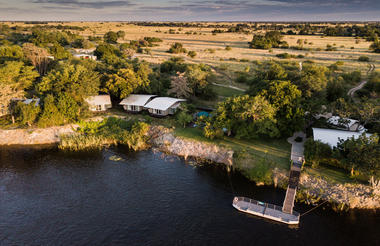
West of town some 20 km is Kalahari sand broadleaf woodland, where species such as African Hobby, White-breasted Cuckoo-shrike, African Golden Oriole, Gray Cisticola, Pale Flycatcher, Southern Black-Flycatcher, and Long-billed Pipit are found.
The areas east and south of town are dominated by Mopane woodland, where the birdlife is similar to Mudumu National Park but also features Black-faced Lovebird.
Wetland areas, including a large depression that filled with water in 1958 but has since been reduced to scattered ponds, now known as Lake LIambezi, and along the river attract waterfowl, shorebirds, and other wetland species, as does the sewage works on the outskirts of town. The area west of town is reached by road to the Zambia border. The road is fringed by Mopane woodland and is notable for night birds after dark when the border is closed. During the day the road is good for birds such as Banded Snake-Eagle, Long-crested Eagle, Dickinson's Kestrel, Brown-necked Parrot, and White-headed Black-Chat.
The Zambezi River itself is fringed by dense forest, which features some specialties such as African Wood-Owl, Trumpeter Hornbill, Crested Barbet, Black-crowned Tchagra, Sulphur-breasted Bushshrike, Gray-headed Bushshrike, Gray Tit-Flycatcher.
Nkasa Lupala tented lodge is built on the banks of one of the many channels of the Kwando-Linyanti river system. This unique Namibian wetland paradise in the eastern Caprivi region, is commonly known as Mamili and was recently renamed Nkasa Lupala/Rupara National Park.
The rooms are built on stilts and the decks are a perfect place to watch the elephants that often visit camp .
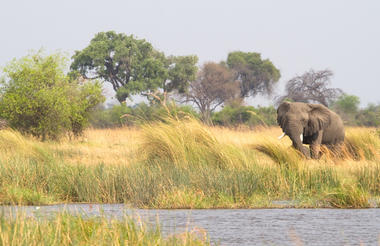
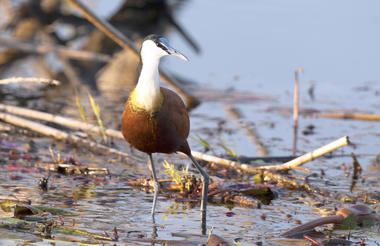
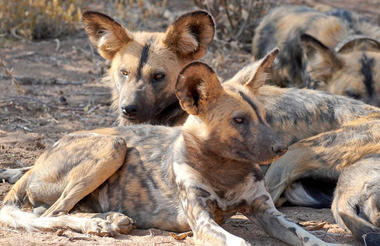
Situated inside the National Park and in Namibia’s Delta. Surrounded by pristine wetlands full of birdlife, elephants, hippos, lechwe, monkeys, crocodiles etc. Water based activities including boat and mokoro tours
Your days at Nkasa Lupala can be spent exploring the National Park which is one of the most remote and wild National Parks in the country. During the rainy season up to 80% of it is under water but between August and November the tracks are passable once more and the wildlife viewing at its best. Although it is possible to explore the area with your own 4x4 you may get more out of the experience by joining a guided tour from your lodge.



Wild – that’s the one word that best describes Nkasa Rupara NP (formerly Mamili) National Park. It is an extraordinary piece of wilderness, waiting to be explored. Lush marshes, dense savannah and high river reeds mean that travelling through the area is a dream for 4×4 enthusiasts. During the dry winter months, large herds of elephant congregate on Nkasa and Lupala islands. But for much of the year, the park is awash with floodwater. Game drives go through the edge of deep pools and close to rivers where crocodiles lie in wait. Nearby buffalo or elephant may be crossing the river. For anyone who relishes the adventures of raw, real Africa, Nkasa Rupara NP National Park is the place to be.
Another great way to explore the wetlands surrounding your lodge is via dug out canoe or boat. Not only is this a great way to see some of the park's larger mammal species as they come to drink but is a perfect way to look for waterbirds and the areas famous painted reed frogs whose distinctive calls fill the air.
One of the great delights of this lodge is just sitting on your raised deck while herds of elephant graze below you or hurry down to the waters edge to drink and bathe.
.jpg)
.jpg)
In a vast arid country, Nkasa Rupara National Park holds the distinction of being the largest wetland area with conservation status in Namibia. Nkasa Rupara NP was proclaimed in 1990, shortly before Namibia’s Independence. And there is much to celebrate about this wet wonderland. The 318-km2 Nkasa Rupara NP protects the flora and fauna living within a complex channel of reed beds, lakes and islands that make up the Linyanti swamps. Spectacular herds of elephant, buffalo, red lechwe and reedbuck are among the highlights of any game-viewing experience. But be careful, the waters are also home to five-metre- long crocodiles and families of hippopotamus, which venture onto the floodplains at night to feed. During the rainy season, areas of the park can become flooded and inaccessible, and yet it remains a sanctuary for birds. With more species of birds recorded here than anywhere else in Namibia, the Park is a bird-watcher’s paradise.
You head west this morning through the Bwabwata National Park until you reach divundu where you will turn south towards Mahango National Park and your home for the next three nights, Nunda River Lodge. This lovely lodge is built on the Okavango River and the individual tented chalets sit right on the banks of the river.
If you arrive too late to drive to the park then a relaxing and rewarding start to your stay at Nunda is on a sunset cruise down the Okavango
From here you can drive daily to the Mahango National Park which sits on both sides of the river. The east has vast herds of buffalo on the flood plains and deep riverine woodlands which is home to many species of birds while the western side is known for its huge Baobab trees and rare sightings of wild dogs, roan and sable antelope, lion, cheetah, leopard, elephants and ground hornbills
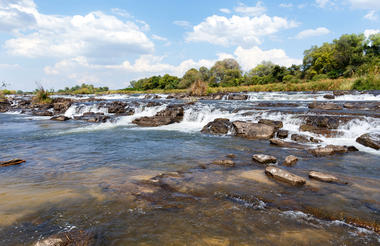
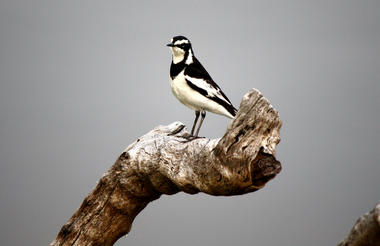
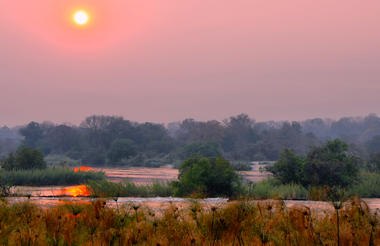
The park is just a few kilometres from your lodge and is split into two sections, one on each side of the river.
The western section of Mahango has three main roads that meet at the Botswana border. The southern road is the most beautiful and has an interesting mix of habitats that support a diverse number of both mammal and bird species that are not seen elsewhere in Namibia. This includes sable and roan antelopes, wild dog and many more.
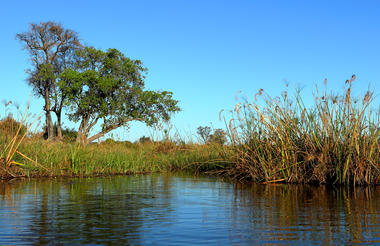
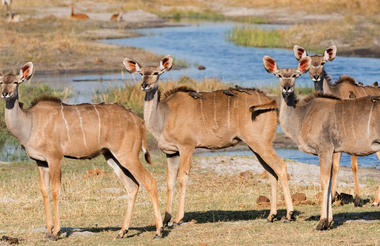
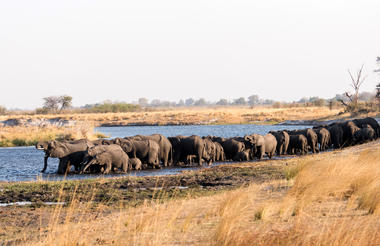
The park is the best place to see the rare Roan and Sable Antelopes. There are also Reedbuck, Tsessebe, Sitatunga, Red Lechwe, Kudu, Chobe Bushbuck, and Steenbok. There are also Elephant, Hippopotamus, Chacma Baboon, Vervet Monkey, and other mammals. The birding is splendid, with threatened species such as Slaty Egret, Wattled Crane, and Black-winged Pratincole possible. Other birds of interest include African Openbill, Long-toed Lapwing, Coppery-tailed Coucal, White-browed Coucal, Burchell's Coucal, and a variety of raptors.
On the eastern banks of the Kavango River lies the Buffalo Core side of the park which has vast floodplains full of grazing antelopes and as the name suggests large buffalo herds. There is a whole area of broad leafed woodlands that support many forest species and the wetlands abound with waterbirds.
Riverdance sits on the banks of the Okavango River opposite Angola. Boat cruises are a particular favourite here with the river housing many hippo pods and tiger fishing being ever popular
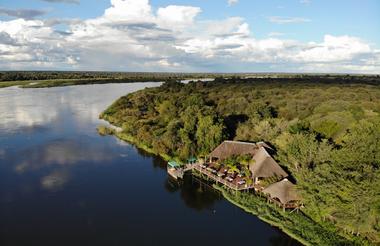
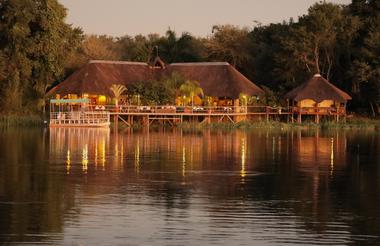
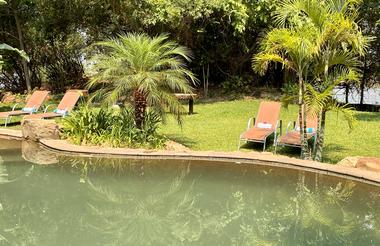
For keen ornithologists, just south of your lodge on the road to Mahango west is an area of rocks in the river which is one of the few places where you can find Rock Pratincole in Namibia. Ask locally for directions.
Tambuti is a small Lodge beautifully perched above the Kavango River overlooking the floodplain. Conveniently located near Rundu town centre but in lush gardens this is the perfect stop over en route south.
There is a small restaurant at the lodge which specialises in local traditional and international food and drinks and is popular with the locals
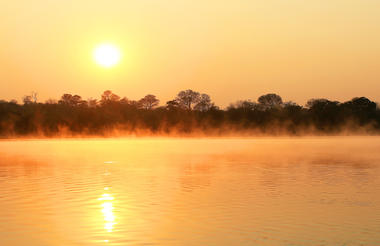
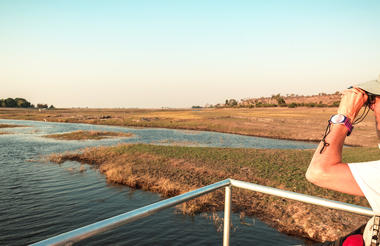
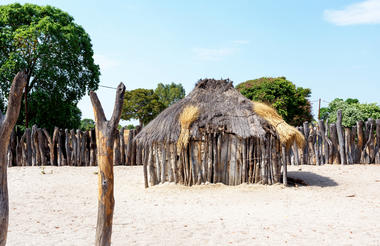
Tambuti is not too far from Nunda River Lodge and is an ideal stop over on the road south to your next destination.
With time on your hands you can return to Mahango in the morning if you wish before heading out to Tambuti
You drive south this morning along the B1 tar road until you reach the turning for Fiume Bush Camp. From here the gravel road takes you deeper into Bushmanland until you get to the lodge.
Your 2 night stay here is all inclusive and the tented en suite chalets are within an easy walk to a working Bushman village.
Here you will have an opportunity to spend time in the village learning how this ancient tribe has survived over the centuries living off the land in one of the most challenging ecosystems in Africa
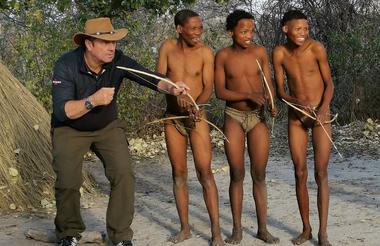
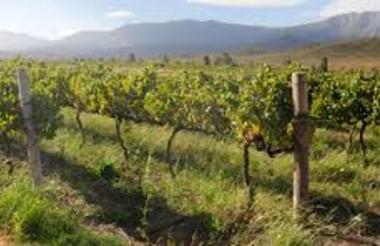
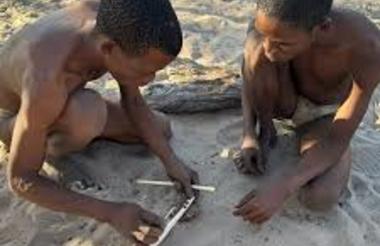
There is a veterinary checkpoint en route to prevent the spread of foot and mouth. and the officers will ask you details of your travel arrangements and will check you are not carrying meat products. They may spray your tyres with disinfectant and ask you to step on a disinfected pad. Once checked they will wave you on your way.
You will have three opportunities to visit the nearby village today. After breakfast you will learn about how the Bushmen survive in this barren land and the workings of the village before you return for lunch.
After some rest time you return once more to watch traditional crafts including how bows and arrows are made and the art of stalking and capturing the animals that are an important part of the Bushman diet. You will also learn about harvesting the nearby trees and bushes and which fruits and leaves can be used for food and medicine and which are used to poison the arrow tips whilst hunting.
Following dinner you will have the opportunity to join the villagers for a traditional evening of dancing and singing around the fire

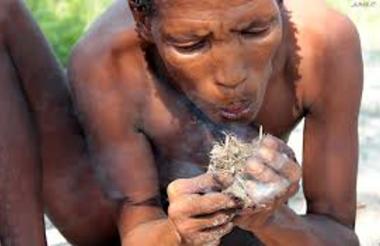
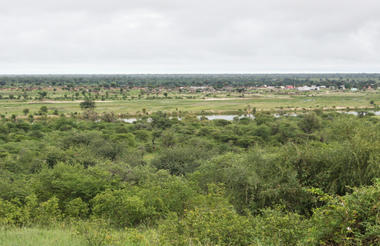
You will be accompanied by a translator from the village to help you communicate with the people and better understand their way of life
You leave the Bushmen this morning and head back to the tar road and south once more until you reach the gates to Okonjima. The lodge lies a further 24km into the middle of the mountains and it is here you will spend your last 2 nights searching for some of the Africa’s biggest carnivores. Options include tracking leopard and spotted hyena from an open vehicle with the aid of a telemetry and visiting the Carnivore Care Centre, headquarters of the Africat Foundation.
With its magnificent rooms, excellent cuisine and genuine conservation story, Okonjima is always a highlight of any trip to Namibia.



This afternoon you have the opportunity to spend time out with your specialist guide in 54,000 acres of pristine bush tracking the resident carnivores who live wild and free, hunting for themselves.
You will receive an early morning call today so you have the chance to enjoy coffee and muffins before you set with your guide on your am trail.
Leopard tracking is often rewarding in the early mornings as the carnivores are still prowling or have made a kill overnight.
By 9.30 you will return to camp for a hearty breakfast before you can retire to your rooms to rest or perhaps enjoy one of the self guided hiking trails on the property.
Your second activity of the day could include the endangered species trail which is often done later in the evening as you will be looking for some of Namibia's rarest nocturnal animals including Aardwolf, Aardvark, Pangolin and Brown Hyena.
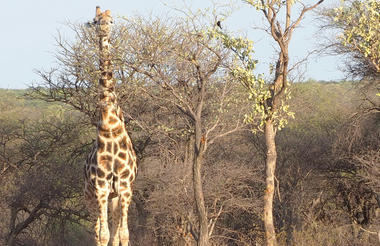
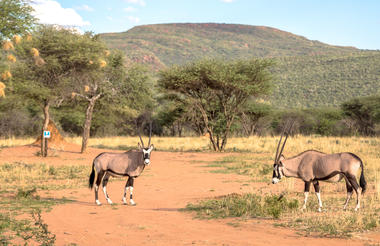
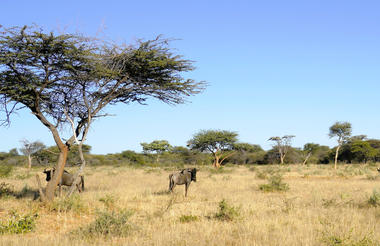
As well as the endangered species and Namibia's carnivores, Okonjima has a number of self guided trails to choose from and the birding here is usually very rewarding with some specialist species such as White-tailed Shrike and Monteiro's Hornbill
After Breakfast you leave Okonjima and travel the three and a half hours back to Windhoek where you return your vehicle before being transferred to the airport for your return or onward flight.






